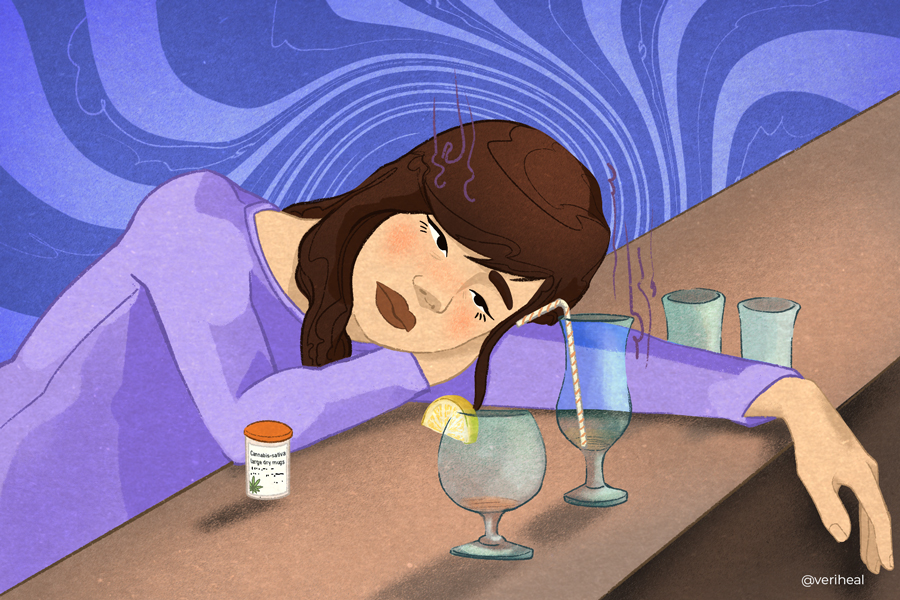Consuming alcohol heavily in young adulthood is associated with an increased likelihood of developing alcohol use disorder (AUD), the most widespread substance-related disorder worldwide. Research has already shed light on the effects of individual differences like alcohol sensitivity and cardiovascular responses in predicting binge drinking behaviors and progression to AUD.
However, there remains a gap in knowledge about how the underlying susceptibility mechanism to AUD works.
Now, new research recently published in Biological Psychiatry takes a closer look at the role of endocannabinoid levels among young people with hazardous alcohol use. What are endocannabinoids’ potential benefits in preventing and treating AUD? Let’s take a closer look to see what the evidence says.
A Brief Refresher on the Miraculous Endocannabinoid System
The endocannabinoid system essentially provides balance and harmony within the body by acting as an internal messenger which links various hormones and neurochemicals that all work together.
Endocannabinoids act as a bridge between each area of the body, helping them to respond to one another on different levels. Because of this, understanding how endocannabinoids impact activities such as learning, memory processing, sleep, and eating, plus how they influence our moods and behaviors, can be extremely powerful for improving our overall health and well-being.
Notably, endocannabinoids are not the same as cannabinoids as the body creates them naturally, whereas cannabinoids are found in the cannabis plant. However, cannabinoids can stimulate the endocannabinoid system, which may be the key to how this study may be excellent news for cannabis users.
What Is FAAH?
FAAH is short for fatty acid amide hydrolase, an important part of the endocannabinoid system in the human body. It’s an enzyme responsible for activating the same CB1 cannabinoid receptor that THC does, helping to maintain proper brain chemistry, communication between cells, and homeostasis of internal functions.
In a sense, it acts as an air traffic control for all the biochemical traffic inside the brain. Without FAAH, things start to get chaotic – which is why some of us act impulsively during certain moments. Nonetheless, FAAH is an integral piece of the puzzle toward unlocking how cannabinoids influence our physiology.
Why You Should Get Your Medical Marijuana Card
Veriheal has satisfied millions of patients nationwide by giving them access to these benefits
- Larger purchase limits
- Peace of mind
- Enhanced legal protection
- Access to higher potency strains
- Save up to 25% on cannabis purchases
- Skip the line at the dispensary
The FAAH Enzyme and Binge Drinking Connection
The research team, led by Isabelle Boileau from the University of Toronto, investigated why some people who drink heavily as young adults do not develop alcohol use disorder. After all, binge drinking in young adulthood makes such disorders far more likely.
Through their investigation, the team hoped to gain new insights and pave a more straightforward path for successful prevention methods in the future. The outcome of this study could have far-reaching effects on themes ranging from adolescent lifestyle choices to addressing health disparities in vulnerable populations.
Recent research has suggested that a FAAH deficiency may lead to heavier and riskier alcohol consumption. Various studies have indicated that endocannabinoid activity plays a role in how much pleasure an individual derives from drinking alcohol – leading researchers to hypothesize that lowered levels of FAAH could be directly related to increased drinking habits over time.
The team’s research is groundbreaking for understanding the link between FAAH activity and alcohol-seeking behavior. Although alcohol overconsumption could be associated with genetic predisposition, the study’s findings suggest an even more nuanced connection.
It appears that decreased FAAH activity in the brain can lead to a higher propensity for seeking out alcohol and a decrease in the negative effects of intoxication. Additionally, the research can clearly illustrate how cravings develop and how to alleviate them. This provides a potentially beneficial scientific backdrop for exploring strategies that promote moderation and avoid reliance on too much alcohol.
How Will These Findings Affect Cannabis Users In The Future?
Scientists now better understand how AUDs develop and progress, along with their relationship to FAAH. With further insight into this topic, cannabis users may benefit from targeted preventive interventions and effective treatments for AUDs. This contributes to an important addition to the body of knowledge on human neuroscience and chemical-based treatments. If these results can continue to be validated, then we could have a revolutionary new outlook on AUD prevention in the near future.
Key Takeaways
This research could not come at a more important time. The fact that FAAH levels may play a role in the susceptibility of young people to developing alcohol use disorder is a vital insight that may help to guide researchers in establishing preventive measures for AUD.
By understanding the chemical pathways of the endocannabinoid system, it is possible to gain more insight into human neuroscience to better understand and treat more complex issues. All in all, these new insights shed light on our endocannabinoid system’s complicated and fantastic mystery, demonstrating yet another example of how it can yield dramatic health results when we know how to utilize it properly.
Author, Share & Comments
















